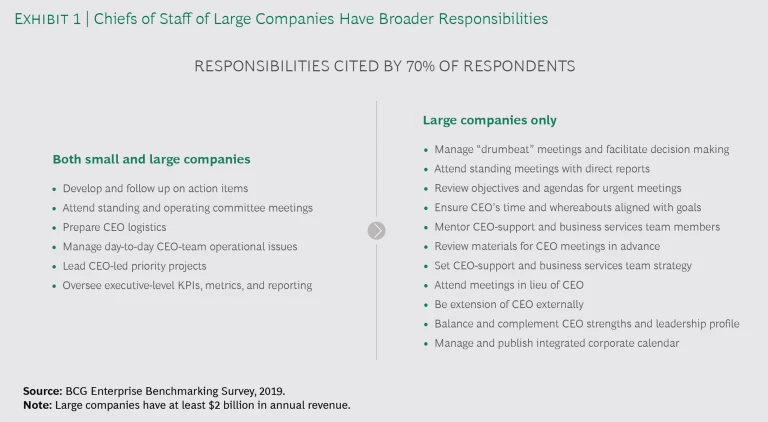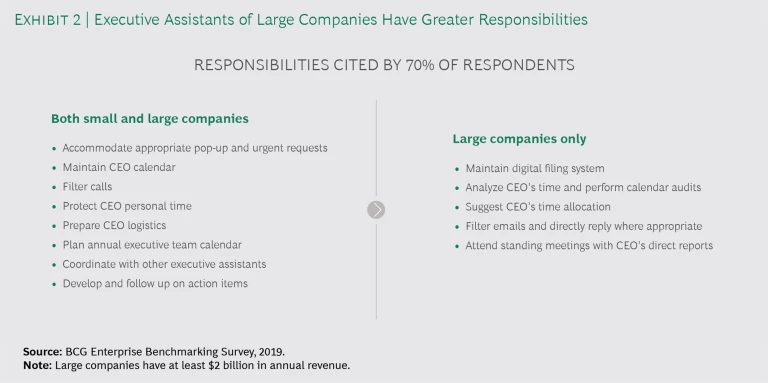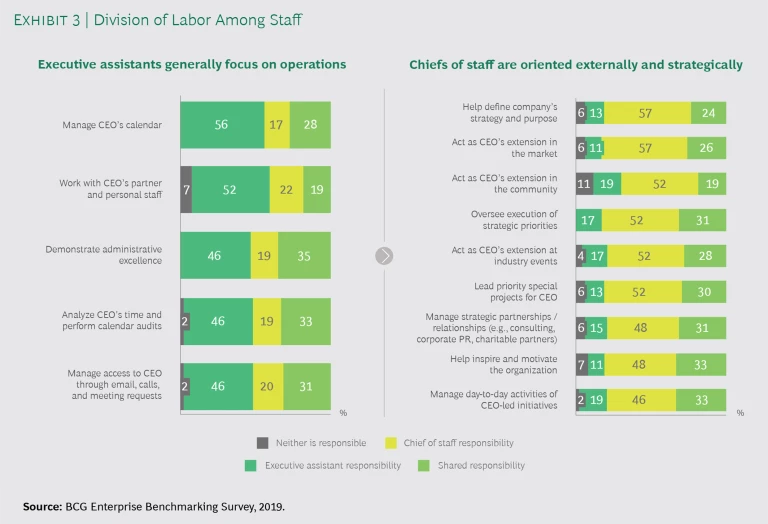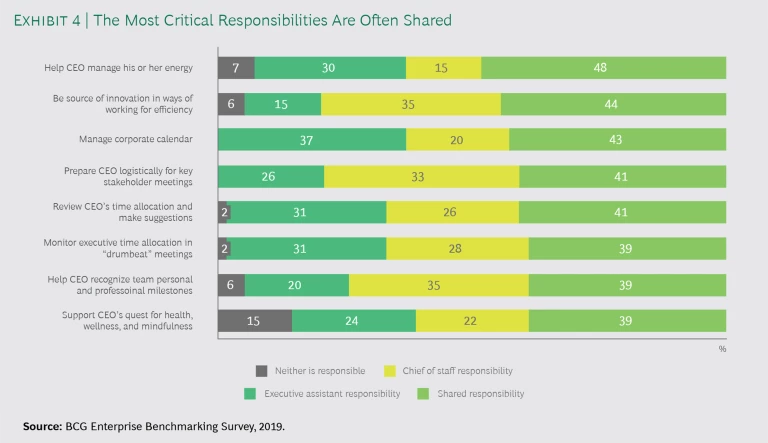The most valuable resources of CEOs are their time and energy. They need to be efficient and effective in each interaction. High-performing support staffs can help their bosses achieve these aims, which are even more important in the coronavirus era, while amplifying their reach and sharpening their focus.
By CEO staff, we mean chiefs of staff and executive assistants (EAs). Less commonly, an organization will have a dedicated office of the CEO. In bringing structure, roles, and practices to the CEO’s day, these critical staff members can boost a CEO’s effectiveness.
As well as actively leading, CEOs must make room for strategically focused reflection and creativity, energizing the organization, and receiving candid feedback. CEO staffs help their bosses identify, prioritize, and protect time for these things, which can make the difference between realized ambition and lost opportunity.
Despite their importance, the inner workings of CEO support staffs are not generally well understood. Two otherwise similar companies can have vastly different staff practices and structures. Our recent, pre-COVID-19 survey of 94 companies and in-depth interviews with EAs and chiefs of staff reveals current practices and suggests some new approaches.
While more than two-thirds of the organizations reported more than $1 billion in revenue, we also surveyed smaller organizations to understand mid-market, high-growth, and entrepreneurial cultures. About 80% of the companies operate globally.
Different Models of CEO Support Staffs
Almost all the companies we surveyed had one or two EAs working full time for the CEO. About two-thirds also had a chief of staff or equivalent role. (See “Who Is the Chief of Staff?”)
Who Is the Chief of Staff?
Who Is the Chief of Staff?
Many companies have a CEO chief of staff, but what that role entails can vary based on the company's context. The chief of staff is frequently a senior position, generally holding a title of vice president or higher—the larger the company, the higher the position in the hierarchy. At companies we surveyed that had at least $2 billion in revenues, 45% of chiefs of staff were a senior vice president or higher, compared with just 33% in smaller companies.
At about 80% of the companies we surveyed, the chief of staff did not hold another position. In the remaining companies, the chief of staff’s most likely second title is head of business development, chief strategy officer, or chief transformation officer.
Smaller companies tended to recruit chiefs of staff from operations and business services, while larger companies were more likely to pull from the finance department or professional services like consulting, or promote a senior executive assistant.
Only 15% of surveyed companies had an office of the CEO. Such arrangements were more common at government agencies; holding companies with large, complex portfolios; and businesses that were undergoing organizational change without the aid of a chief transformation officer. These offices tended to have ten or fewer employees, including executive assistants, chiefs of staff, and often the heads of legal, business development, administrative, public relations, and increasingly corporate strategy.
In our survey, most companies with an office of the CEO had at least $2 billion in revenue. The CEO staffs of large companies also tended to have greater breadth of responsibilities and duties. (See exhibits 1 and 2.)
Ultimately, however, the organization of a CEO’s staff is less important than the scope of support and how its members work together. Here’s what we learned from our research.
How a Staff Helps the CEO Succeed
Similar to most other staff functions, the CEO’s support staff needs to master both strategic and tactical activities. Great staffs are defined by their ability to deliver broad objectives and have influence on the organization. (See exhibits 3 and 4.)
Orchestrating the Calendar. The calendar is a primary tool for driving CEO effectiveness. Putting an item on the calendar explicitly establishes its importance. As a strategic tool, the calendar should broadly reflect the organization’s priorities over the next 12 to 18 months. If it does not, the urgent will swamp the important. Hence, skillfully managing a calendar is one of the staff’s most important roles.
CEOs have more control over their calendars than they might realize. Their staffs can help them orchestrate the timing of board interactions, investor outreach, customer visits, and staff meetings so that they are “on” when it matters most. “In every day, there are probably only 200 minutes that really matter,” explained one CEO.
Managing a Calendar’s Rhythm. A calendar is more than a collection of appointments; it should have a rhythm of public events, one-on-one conversations, reflection, professional activities, and personal time.
One of the hardest jobs of the CEO’s staff is saying no. To preserve the flow of the day and reserve time for what is truly important, a critical calendar task is to screen internal meetings and turn away well-meaning executives and teams whose affairs can be handled elsewhere. To do so, the staff needs to win the CEO’s trust and internalize his or her chief concerns.
On the flip side, the staff should be opening time in the calendar for communication with employees. For example, CEOs need to hear regular, candid feedback. Ideally, honest brokers come from throughout the organization—not just near the top. And as part of succession planning and talent development, CEOs must meet with high-potential reports. They should also be meeting regularly with the top 40 to 50 leaders in the company. These meetings will occur in a variety of settings, from one-on-one and formal meetings to time outside of headquarters. A skillful staff can play a role in making sure that such conversations, and appropriate venues, are built into the calendar over the course of the year.
In addition to highlighting strategic priorities, a calendar should carve out room for solitude. Successful CEOs need not only to be present and convey energy but also to be able to step back, slow down, reflect, and imagine —to engage in the System 2 thinking popularized by psychologist Daniel Kahneman in Thinking, Fast and Slow. This practice leads to better insights into innovation, strategy, and execution. It improves outcomes and credibility with boards, leaders, employees, and other stakeholders. With discipline, structure, practice—and the help of their support staff—even the most harried CEO can find time to reflect. Finally, the CEO’s work calendar will allot time for exercise, family commitments, and medical appointments.
By thoughtfully and skillfully guiding the flow of the calendar, a support staff can help the CEO navigate fluidly through both time demands of internal and external stakeholders and personal commitments. One EA said that she set aside time at the end of each month for what she calls a “look back and look ahead,” identifying what went well and what did not go well in the past and finding ways to build momentum in the future.
Of course, the CEO’s calendar is a moving target and beyond the full control of staff. Emergencies, urgencies, and contingencies will always arise. One of the staff’s most valued proficiencies is the ability to juggle the anticipated demands on the CEO’s time while organically building in flexibility for unexpected events.
Extending the CEO’s Reach. Chiefs of staff and EAs likely spend more time with the CEO than other employees do. They are thus well suited and situated to explain, repeat, and boost key CEO messages.
Effective CEO staffs represent the CEO, the company, and the brand to the board, associates, customers, vendors, and the world with every interaction.
Executive assistants or chiefs of staff, for example, can often act as a proxy for the CEO with both external and internal audiences. Outside the organization, they can attend industry events, develop relationships with stakeholders and partners, and lead CEO passion projects. Internally, they can manage senior leader “drumbeat” meetings and be active members of many work communities. As one CEO told us, “An effective EA represents not only the CEO but also the company and the brand to the board, associates, customers, vendors, and the world with every interaction.”
Both EAs and chiefs of staff routinely reply to the CEO’s email and draft internal communications. In performing these actions, they are effectively the CEO’s brand ambassadors. As one CEO described it, “An executive assistant can be a step ahead, actively take work off the CEO’s plate—but always in a way the CEO would have done.”
Integrating and Networking. CEO staffers should be effective networkers and CEO brand builders. Through their interactions, they can build trust and transparency, demonstrate integrity and honesty, and encourage candid feedback. In some ways, they are the ultimate integrators in a large organization.
In some ways, CEO staffs are the ultimate integrators in a large organization.
Staffers can also act as their bosses’ eyes and ears in the organization. They can provide a general perspective about employee concerns that CEOs are unlikely to hear on their own. One chief of staff, for example, conducts “listening tours” across departments. She brings back topics and best practices to the CEO and makes connections between groups working on similar problems.
A staff’s relationship with the CEO’s senior leadership team is especially crucial. The executives on the team should be able to raise concerns with the support staff members and trust that they can synthesize and convey these issues anonymously to the CEO.
It’s not enough for the chiefs of staff to build personal relationships with the CEO’s direct reports. They also must understand and be fully conversant with the key strategic and operational issues while demonstrating business acumen, judgment, and pragmatism. This combination of relationships and content generates influence and creates visibility. A chief of staff looks to make connections, assess root causes, spotlight quality data and insights, frame decisions, and illuminate disagreements and disconnects among the executive leadership. The goal is to improve and speed decision making. “An effective chief of staff gains the trust not only of the CEO but also the CEO’s direct reports. He or she can facilitate the discussion of difficult issues and help ensure that these issues are dealt with,” one chief said.
Leaping Beyond the Basics
A CEO’s staff needs to earn the right to play a strategic role by mastering the basics of the boss’s job, especially two core elements. First, working closely with the CEO, staffers need to create an office or support architecture with the size, structure, and responsibilities to fit the occasion and context—for example, an imperial court is the wrong approach for a company in distress. And startups, whose CEOs are often pulled in a million directions, can often benefit from a chief of staff and focused support staff to support rapid growth and scale. Second, the staff’s cooperation, communication, and preparation will largely shape its performance as a team.
Locked In and Aligned. The CEO’s staff needs to be on board with the CEO’s strategy for the next three to five years. These are jobs for disciples, not doubters. They also need to cooperate and get along. To provide the most effective support, the staff needs to be dialed in as a coherent unit. Even one misalignment in values, personality, or temperament can drain its effectiveness and energy. Senior leadership teams commonly take personality and behavioral tests such as DiSC or Myers-Briggs to gain a better understanding of one another. These exercises are also valuable for the CEO’s staff, especially when responsibilities are shared among staff members, as they are for many of the most important activities, such as managing the CEO’s energy, meeting preparation, and time allocation.
Communication and Cooperation. CEOs and their staffs should spend time figuring out the most effective way to communicate. As simplistic as this advice sounds, in the age of Slack, Trello, and Evernote and virtual teaming necessitated by the coronavirus, it makes sense to talk about how to talk. Face-to-face meetings should be in the mix. A chief of staff for a famous television star recalls asking her boss for feedback. The executive admitted that she “hated being chased down the hall” for a decision. So the chief of staff began to use her boss’s morning hair appointment for face-to-face meetings. “In the end,” one chief of staff said, “what made a good working relationship was the energy, connection, and commitment between the CEO and me.”
Professional Development and Exposure. CEOs’ support staffs are sometimes overlooked in the professional development process and budget. Given their importance, this is a missed opportunity. The staff should have professional development plans and access to training, coaching, and coursework. Some of the surveyed companies, for example, have budgets allowing staff to network with their peers at other companies, work with coaches, and receive leadership, technology, and skills training. For example, OfficeNinjas—an organization that provides networking, education, and training for administrative and operations staff—hosts an annual conference called OfficeNinjas Con in partnership with experts and academic institutions, like the University of California, Berkeley Haas School of Business.
Development opportunities need not all be formal. Staff can also develop leadership skills and make connections by participating in broad-reaching corporate initiatives such as purpose, sustainability, diversity and inclusion, and mental health.
Because it is a small team, a CEO’s support staff can escape attention as a unit that makes a big difference. (See “Orchestrating for Success.”) But by virtue of its proximity to the CEO and understanding of the boss’s agenda, it can play an outsized role in piloting the organization to success. If the staff and CEO are in sync, they will collectively boost the return on one of an organization’s most precious resources: the CEO’s time.
Orchestrating for Success
Orchestrating for Success
Great CEO staffs do not just happen. They are nurtured. For organizations that have not worked on expanding this potential source of energy and influence, here are a cautionary note and a three-pronged approach to cultivating an effective CEO staff. The caution, which should be unsurprising: One size will not fit all. The team will be in a continual state of adjustment and refinement depending on the business context and the CEO’s need. The approach:
- Start by reflecting on the current system and schedule management, diagnosing the CEO’s time allocation, assessing time reserved for reflection and strategy, and understanding how last-minute requests are managed. Many CEOs do not routinely schedule time with their staff to discuss how to work together effectively.
- Be clear about individual roles and responsibilities, especially those that are shared. While all members of the team are helping the CEO, they do not all help in the same way.
- Develop simple tools to track time against priorities and follow-up items that need attention. A straightforward “focus list” for follow-up items could serve as a tracking instrument but also more generally as a contextual aid. Ensure that the daily calendar broadly reflects immediate priorities as well as a rolling four-week view of the calendar that is in sync with longer-range priorities.
Depending on the organization’s complexity, geographic scope, and culture, the team should be able to fully implement a CEO management system and new set of staff behaviors within four to eight months. This system should manage time, drive decision making and action, establish accountabilities, and develop shared norms to ensure healthy communications within and beyond the team.
Leadership by Design: Navigate the complexities of today’s leadership and management environment.
BCG’s CEO Advisory
BCG’s CEO Advisory practice supports the success of current and prospective CEOs through individual guided self-reflection and counsel as well as the convening of peer forums.















